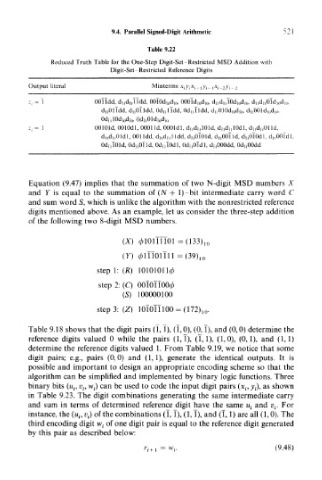Page 536 - Introduction to Information Optics
P. 536
9.4. Parallel Signed-Digit Arithmetic
Table 9.22
Reduced Truth Table for the One-Step Digit-Set-Restricted MSB Addition with
Digit-Set-Restricted Reference Digits
Output literal Minterms x iy ix i_ ly i. lx i_ 2yi-2
OOTIdd, dj,d T,TIdd, OOTOd Tod ro, OOOTd T()d IO, di.diJOdjodfo, d T ,d ri OTdj ( »d 1(h
d T ,OlTdd, dnOTldd, Od Tl lTdd, Od r ,Tldd, d Tl010d Tod To, d T,001d I0d K1,
Od T,10d Tod To, OdnOldrodjo
OOlOld, OOlOdl, 0001 Id, OOOldl, dj,d Tl 10Id, dndnlOdl, d Tl d T ,011d,
d Tldi,01dl, 001 Idd, d T ,di,Hdd, d T,Ol01d, d T,OOlld, d T,OTOdl, d hOO!di,
Od riT01d, Od r,OTld, Od n IOdl, Od nOTdl, d,,000dd, Od TlOOdd
Equation (9.47) implies that the summation of two N-digit MSD numbers X
and Y is equal to the summation of (N + I) -bit intermediate carry word C
and sum word S, which is unlike the algorithm with the nonrestricted reference
digits mentioned above. As an example, let us consider the three-step addition
of the following two 8-digit MSD numbers.
(X) 0101IIT01 =(133)i 0
(Y) 01TT01T11 =(39) 10
step 1: (R) 101010110
step 2: (C)
(S) 100000100
step 3: (Z) lOMIlOO - (172) 10.
Table 9.18 shows that the digit pairs (T, I), (T, 0), (0, 1), and (0, 0) determine the
reference digits valued 0 while the pairs (1,1), (1,1), (1,0), (0,1), and (1, I)
determine the reference digits valued 1. From Table 9.19, we notice that some
digit pairs; e.g., pairs (0,0) and (1,1), generate the identical outputs. It is
possible and important to design an appropriate encoding scheme so that the
algorithm can be simplified and implemented by binary logic functions. Three
binary bits («,., v t, w,-) can be used to code the input digit pairs (x t, y t), as shown
in Table 9.23. The digit combinations generating the same intermediate carry
and sum in terms of determined reference digit have the same u t and u,.. For
instance, the (w r-, v,.) of the combinations (T, !),(!, T), and (T, 1) are all (1, 0). The
third encoding digit w ; of one digit pair is equal to the reference digit generated
by this pair as described below:
r l+ 1 = w,.. (9.48)

